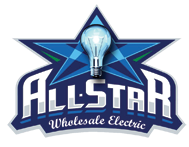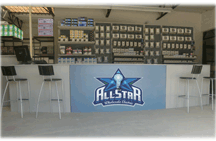All Star Wholesale Electric is a full-line electrical wholesaler and lighting distributor, All Star Wholesale stocks and sells a full range of electrical and lighting supplies including |
|
||
ALL STAR WHOLESALE ELECTRICWHOLESALE ELECTRIC SUPPLY & LIGHTING 13810 S. PRAIRIE AVE. The most efficient source of electric light is the low-pressure sodium lamp. It produces an almost monochromatic orange light, which severely distorts color perception. For this reason, it is generally reserved for outdoor public lighting usages. Low-pressure sodium lights are favoured for public lighting by astronomers, since the light pollution that they generate can be easily filtered, contrary to broadband or continuous spectra. Incandescent light bulbIncandescent light bulb as we know it today, with a coiled filament of tungsten, was commercialized in the 1920s developed from the carbon filament lamp introduced in about 1880. As well as bulbs for normal illumination, there is a very wide range, including low voltage, low-power types often used as components in equipment, but now largely displaced by LEDs There is currently interest in banning some types of filament lamp in some countries, such as Australia planning to ban standard incandescent light bulbs by 2010, because they are inefficient at converting electricity to light. Sri Lanka has already banned importing filament bulbs because of high use of electricity and less light. Less than 3% of the input energy is converted into usable light. Nearly all of the input energy ends up as heat that, in warm climates, must then be removed from the building by ventilation or air conditioning, often resulting in more energy consumption. In colder climates where heating and lighting is required during the cold and dark winter months, the heat byproduct has at least some value. Halogen lampHalogen lamps are usually much smaller than standard incandescents, because for successful operation a bulb temperature over 200 °C is generally necessary. For this reason, most have a bulb of fused silica (quartz), but sometimes aluminosilicate glass. This is often sealed inside an additional layer of glass. The outer glass is a safety precaution, reducing UV emission and because halogen bulbs can occasionally explode during operation. One reason is if the quartz bulb has oily residue from fingerprints. The risk of burns or fire is also greater with bare bulbs, leading to their prohibition in some places unless enclosed by the luminaire. Those designed for 12 V or 24 V operation have compact filaments, useful for good optical control, also they have higher efficacies (lumens per watt) and better lives than non halogen types. The light output remains almost constant throughout life. Fluorescent lampFluorescent lamps have much higher efficacy than filament lamps. For the same amount of light generated, they typically use around one-quarter to one-third the power of an incandescent. Fluorescents were mostly limited to linear and a round 'Circline' lamp until the 1980s, with other shapes never gaining much popularity. The compact fluorescent lamp (CFL) was commercialized in the early 1980s. Most CFLs have a built-in electrical ballast and fit into a standard screw or bayonet base. Some make use of a separate ballast so that the ballast and tube can be replaced separately. Typical average lifetime ratings for linear fluorescent tubes are 10,000 and 20,000 hours, compared to 750 hours (110 V) and 1000 hours (240 V) for filament lamps. Some types of fluorescent lamp ballast have difficulty starting lamps in very cold conditions, so lights used outdoors in cold climates need to be designed for outdoor use to work reliably. Fluorescents come in a range of different color temperatures. In some countries cool white (CW) is most popular, while in some, warmer whites predominate. In America, fluorescents most often come in cool white (CW), with some home bulbs being a warm white (WW), which has a pinkish color. In between there is an "enhanced white" (EW), which is more neutral. There is also a very cold daylight white (DW). Compact fluorescent lamps are usually considered warm white, though many have a yellowish cast like an incandescent. "Warm" and "cool" are entirely relative terms and almost arbitrary so color temperature and the color rendering index (CRI) are used as absolute scales of color for fluorescents, and sometimes for other types of lighting. LED lampSolid state LEDs have been popular as indicator lights since the 1970s. In recent years, efficacy and output have risen to the point where LEDs are now being used in niche lighting applications. Indicator LEDs are known for their extremely long life, up to 100,000 hours, but lighting LEDs are operated much less conservatively (due to high LED cost per watt), and consequently have much shorter lives. Due to the relatively high cost per watt, LED lighting is most useful at very low powers, typically for lamp assemblies of under 10 W. LEDs are currently most useful and cost-effective in low power applications, such as nightlights and flashlights. Colored LEDs can also be used for accent lighting, such as for glass objects, and even in fake ice cubes for drinks at parties. They are also being increasingly used as holiday lighting. LED efficacies vary over a very wide range. Some have lower efficacy than filament lamps, and some significantly higher. LED performance in this respect is prone to being misinterpreted, as the inherent directionality of LEDs gives them a much higher light intensity in one direction per given total light output. Single color LEDs are well developed technology, but white LEDs at time of writing still have some unresolved issues.
LED technology is useful for lighting designers because of its low power consumption, low heat generation, instantaneous on/off control, and in the case of single color LEDs, continuity of color throughout the life of the diode and relatively low cost of manufacture. In the last few years, software has been developed to merge lighting and video by enabling lighting designers to stream video content to their LED fixtures, creating low resolution video walls. For general domestic lighting, total cost of ownership of LED lighting is still much higher than for other well established lighting types. Carbon arc lampCarbon arc lamps consist of two carbon rod electrodes in open air, supplied by a current-limiting ballast. The electric arc is struck by touching the rods then separating them. The ensuing arc heats the carbon tips to white heat. These lamps have higher efficacy than filament lamps, but the carbon rods are short lived and require constant adjustment in use. The lamps produce significant ultra-violet output, they require ventilation when used indoors, and due to their intensity they need protecting from direct sight. Carbon arc lamps operate at high powers, and had high efficacy compared to other pre-1920s light sources. They also are a point source of light. These properties made them ideally suited to search lights, follow spots and film projector lights. Their need for ongoing attendance and adjustment, and frequent rod replacement made them ill suited to general lighting, though they were used for high power lighting in the years when nothing else with comparable output power existed. Carbon arcs fell out of use even for niche applications during and after World War 2. Discharge lampA discharge lamp has a glass or silica envelope containing two metal electrodes separated by a gas. Gases used include, neon, argon, xenon, sodium, metal halide, and mercury. The core operating principle is much the same as the carbon arc lamp, but the term 'arc lamp' is normally used to refer to carbon arc lamps, with more modern types of gas discharge lamp normally called 'discharge lamps'. With some discharge lamps, very high voltage is used to strike the arc. This requires an electrical circuit called an igniter, which is part of the ballast circuitry. After the arc is struck, the internal resistance of the lamp drops to a low level, and the ballast limits the current to the operating current. Without a ballast, excess current would flow, causing rapid destruction of the lamp. Some lamp types contain a little neon, which permits striking at normal running voltage, with no external igniter circuitry. Low pressure sodium lamps operate this way. The simplest ballasts are just an inductor, and are chosen where cost is the deciding factor, such as street lighting. More advanced electronic ballasts may be designed to maintain constant light output over the life of the lamp, may drive the lamp with a square wave to maintain completely flicker-free output, and shut down in the event of certain faults. These more complex ballasts are chosen in the film industry for example. Lamp life expectancyLife expectancy is defined as the number of hours of operation for a lamp until 50% of them fail. This means that it is possible for some lamps to fail after a short amount of time and for some to last significantly longer than the rated lamp life. This is an average (median) life expectancy. Production tolerances as low as 1% can create a variance of 25% in lamp life. For LEDs, lamp life is when 50% of lamps have lumen output drop to 70% or less. Lamps are also sensitive to switching cycles. The rapid heating of a lamp filament or electrodes when a lamp is turned on is the most stressful event on the lamp. Most test cycles have the lamps on for 3 hours and then off for 20 minutes. (Some standard had to be used since it is unknown how the lamp will be used by consumers.) This switching cycle repeats until the lamps fail and the data is recorded. If switching is increased to only 1 hour on, the lamp life is usually reduced because the number of times the lamp has been turned on has increased. Rooms with frequent switching (bathroom, bedrooms, etc.) can expect much shorter lamp life than what is printed on the box.
Ballasts & Transformers
|
|||
| Contact Information | |||
| If you have questions or comments about All Star in general, please complete our Contact Us Form. | |||
| Visit us at: | |||
| All Star Wholesale Electric 13810 S. Prairie Ave. Hawthorne, CA 90250 TEL: (424) 236-4492 FAX: (424) 236-4495 Toll Free: 888-712-8198 |
|||

